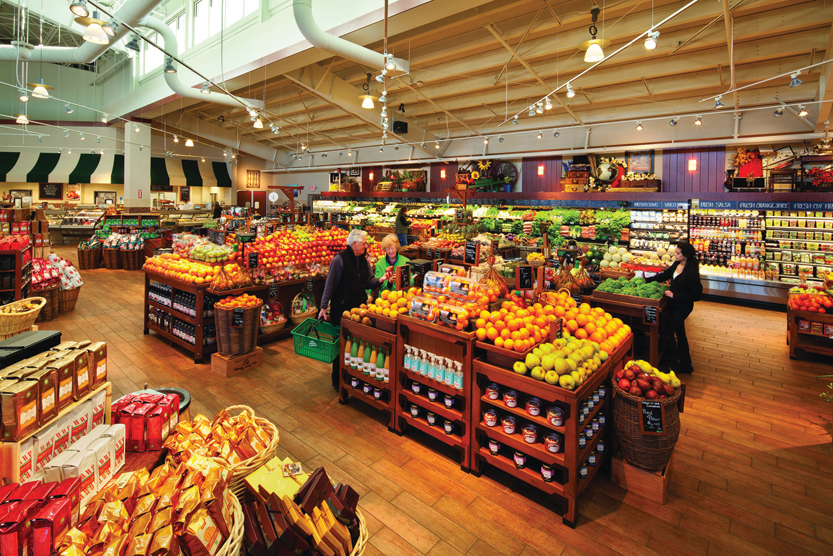As Craig Carlock sees it, service isn’t something you can bolt onto a shopping trip, but rather is a quality woven into the experience itself.
“We want people to come into our store and have a great food experience,” Carlock, the president and chief executive officer of The Fresh Market, told SN in an exclusive interview last week. “That experience includes how the store looks, and the scents in the store — freshly brewed coffee and an open bakery, so you get a sense there’s something good in the oven. We know the experience includes the appearance of our employees, so we have dress codes and standards we follow. It includes the cleanliness of the store and the freshness and vibrancy of the products.
“The store itself is designed with service in mind,” he added. “For example the meat department is all full service. We want customers to pick the items in the meat case they would like and have us weigh them, wrap them and give them advice. The service is built into the store.”

Such “built-in” service, augmented by extensive training programs and proprietary expertise in merchandising and buying, gives Carlock confidence as he expands The Fresh Market — once a regional niche player — into a nationwide operator. The retailer, which today operates 129 stores in 25 states, opened for the first time late last year in California and later this year will debut in Texas. Observers anticipate the company will post $1.3 billion in sales for the 2012 fiscal year, which ended last week.
The Fresh Market was founded in Greensboro, N.C., in 1982 by Ray Berry and his wife Beverly. Ray was a former vice president of the Southland Corp., parent of the 7-Eleven chain, and left that company in 1980 with the notion of opening a store that evoked an open European market. Deciding on Greensboro upon the suggestion of a stranger, Berry built an intimate and high-service food store at the site of a 14,000-square-foot former Bi-Rite supermarket. He utilized low lighting and piped-in classical music to complement a rustic, open design and a merchandising style — loose produce and large bins of bulk items — that conventional food retailers had eschewed in favor of more sterile presentation.
 In the 30 years since that store opened, trends have come to favor many of the attributes Berry had in mind when he opened it. While discounters and mass merchandisers attacked those food categories The Fresh Market only dabbles in, interest has exploded in healthier eating, home entertaining and the “foodie” culture the store was made to serve. Its small footprint — most stores are about 20,000 square feet — meets a consumer interest in convenience while allowing for more versatile and less expensive expansion opportunities. The Fresh Market also stands to benefit from an aging population that disproportionately buys food for home consumption and emerged as a leading player in the “luxury” market — which analysts note is underpenetrated and hugely fragmented among food stores.
In the 30 years since that store opened, trends have come to favor many of the attributes Berry had in mind when he opened it. While discounters and mass merchandisers attacked those food categories The Fresh Market only dabbles in, interest has exploded in healthier eating, home entertaining and the “foodie” culture the store was made to serve. Its small footprint — most stores are about 20,000 square feet — meets a consumer interest in convenience while allowing for more versatile and less expensive expansion opportunities. The Fresh Market also stands to benefit from an aging population that disproportionately buys food for home consumption and emerged as a leading player in the “luxury” market — which analysts note is underpenetrated and hugely fragmented among food stores.
“The company and the concept benefit as people look to make more healthy choices,” acknowledged Carlock, an Atlanta native and former Procter & Gamble executive who joined The Fresh Market as director of marketing when it was a 25-store, $150 million retailer in 1999. “We appreciate that tailwind, and we think it’s here to stay.”
Read more: The Fresh Market Boosts Outlook
At the same time, it would be a mistake to think The Fresh Market is simply benefiting as a result of prevailing conditions. Its success, observers say, resides in discipline and execution on multiple fronts ranging from buying and merchandising to real estate and employee training. The company’s ability to replicate these attributes as it expands to its farthest reaches yet will be the ultimate test of the concept.
Jay Jacobowitz, president of Brattleboro, Vt.-based natural products industry consultant Retail Insights, described The Fresh Market’s combination of a compact footprint and a focus on doing a few categories well as a “coat of armor” that protects its concept and fosters the consistency it seeks.
“They are able to concentrate on just a few very important things: The produce category and the fresh meat case. They put that in a compact footprint and they go to town,” Jacobowitz told SN. “It’s the philosophy of putting all their eggs in a few baskets and watching those baskets every carefully, rather than being spread out and distracted trying to be all things to all people.
“That,” he said, “is a strength.”
The Efficient Frontier
Whether their interest is in finances or food, observers discussing The Fresh Market invariably come around to similar conclusions: They admire the company’s discipline and execution.
“We call The Fresh Market ‘the efficient frontier company,’” said Mark Miller, an analyst with William Blair & Co., Chicago, referring to the investment concept that describes the best possible return at a given level of risk.
“In supermarket terms, they raise the level of food quality until the point where the plant gets too expensive for each increment of quality, so they find the most efficient point, or the highest-quality offering for the money, to give a good value.
“It’s also in the way they’ve selected sites,” Miller added. “They get good locations up to the point where it becomes not worthwhile to pay up for better visibility or better access. The outcome is that the company has one of the highest returns on invested capital of any in our research universe, and the highest in food retailing.”

Chuck Cerankosky, an analyst following The Fresh Market with Northcoast Research in Cleveland, said the chain’s compact box requires a disciplined and consistent approach, noting there is little room to not get it right from one location to the next.
“I think for an upscale operator what I think is different is how relatively uniform their execution plan is from one part of the country to another,” Cerankosky said. “If you look at Kroger, they have such a wide variety of stores in the areas they are operating in. They don’t try to be either upscale or downscale — they are all over the place. Even Whole Foods has widely varying store sizes and shapes. But at The Fresh Market the store size, store mix and layout is all very uniform. That helps the execution.
“In a 20,000-square-foot format you have to have discipline because you can’t be all things to all people,” Cerankosky added. “You can’t be totally organic or totally fresh.”
The Fresh Market concedes dedicated organic shoppers to competitors like Whole Foods and Earth Fare, but, Jacobowitz noted, that’s not as significant a roadblock to its business as it might appear.
“They are giving ground to Whole Foods by not being organic. But the secret is organics doesn’t drive Whole Foods business as much as the public thinks, especially in prepared foods,” he said. “[Fresh Market executives] have correctly identified they don’t need organics to appeal to households that can afford it, that love to eat well and love to entertain, and love to feel good about their shopping, but don’t live and die by organics.”
Whole Foods’ growth in fact probably helped The Fresh Market by demonstrating that demand for fresh foods was going unmet by conventional stores, upending the industry, Jacobowitz said. The Fresh Market has thrived in this new world.
 “Essentially everyone from the small regional grocer to the national chain have been trying to play catch-up [to Whole Foods], and all of it is driven at the household level, by the end user consumer who wants a higher-quality food experience. And higher quality in the minds of consumers equals fresh. The two are synonymous,” he said.
“Essentially everyone from the small regional grocer to the national chain have been trying to play catch-up [to Whole Foods], and all of it is driven at the household level, by the end user consumer who wants a higher-quality food experience. And higher quality in the minds of consumers equals fresh. The two are synonymous,” he said.
“Well, you can’t get any more relevant or to the point that the name of the store: The. Fresh. Market. Three words, two of them are generic — ‘The’ and ‘Market.’ The defining word is ‘Fresh.’ So really, what you see is what you get. And they deliver on that promise.”
The Fresh Market aims to provide competitive prices on items that are directly comparable to items sold by competitors, such as beer, wine, dairy and food staples, but aims to price perishables at a premium that is commensurate with the higher quality of its offerings. The company shops for its produce and meats from a variety of suppliers with an eye on distinguishing characteristics including taste, color, size, marbling, growing conditions, origins and freshness.
“Our Red Delicious apples, because of their size, color and lack of bruising, are priced at a premium to those carried at many traditional supermarkets,” the company said in a filing. “Our ground beef, because it is ground in our stores every day, is priced at a premium to that which is carried by many conventional supermarkets, which may purchase their ground beef frozen and in bulk.”
These products are merchandised with flair and sold by a motivated staff.
“Their lead card is produce, which isn’t necessarily organic but by golly, it’s the most gorgeous presentation in the industry, bar none,” Jacobowitz maintained. “I think nobody does fresh presentation as well as The Fresh Market, and that includes the meat case as well.”
SN Blog: The Fresh Market's Approach Fosters Partnerships
Carlock said training is an integral part of The Fresh Market’s formula and is woven into the company’s culture and expansion. Nearly all of its store managers are hired from within — assistant store managers work from one to three years before becoming managers, who in turn are deployed to operate the retailer’s growing fleet of new stores. Hourly workers, many of whom come from other food stores, are often excited by the opportunity to interact with shoppers and sell quality products, he added.
“We hire [assistant managers] with an interest in both managing people and interacting with customers — we want that desire and aptitude, and we test for it,” Carlock said. “We also have good training for department heads, who are the experts in our food categories. The produce manager, the meat manager and the deli manager get special training so that all the folks have the technical skills to run a department.
“We’ve tried to make the training connect with other parts of how we run the company and the stores,” he added. “For example our review program, how pay raises roll in, are linked to the financial results and the training success that our folks have. So there’s a consistency of message, we believe, between how well people are trained, and how their financial results come along, and how they are paid. That brings it all together, so that training isn’t off in a corner but at the center of the plate.”
Lots of Dots
With a focus not directly on supermarkets — just on their wealthiest customers and most profitable categories — The Fresh Market is a small but dangerous competitor, observers say.
“If you take a step back and look at the higher end of the food market, it’s still underserved,” said Miller, the analyst at William Blair. “If you took the specialty or luxury offerings in another category like apparel or automobiles or coffee, you’d see they are much better served. There is a greater penetration of offerings that have been developed over time than there have been for food. So when The Fresh Market goes into a market for the first time there is a latent demand for them. Invariably, people shopping at conventional markets actually find that The Fresh Market is better suited for them.”
“I don’t think they elicit a huge response from competitors,” Cerankosky said. “Their impact on a market is good for them, but it’s not such that Safeway says, ‘Uh-oh, we have to start doing something differently.’ I think they focus on having well-appointed stores in areas that can support their pricing structure, but I don’t think they are a disruptive operator.”
 Jacobowitz describes The Fresh Market as an “irritant” to larger competitors for fresh business like Wegmans or Whole Foods. Conventional supermarkets in its path of growth would do well to assess and play up their strengths, and be certain their stores are in good physical shape, he said.
Jacobowitz describes The Fresh Market as an “irritant” to larger competitors for fresh business like Wegmans or Whole Foods. Conventional supermarkets in its path of growth would do well to assess and play up their strengths, and be certain their stores are in good physical shape, he said.
“You’re going to take a hit,” he said. “I’d make sure my lines of credit are open and refreshed, and my physical presentation is up to snuff. If you’ve been riding the depreciation number down to net-out value, make sure you replenish the cap-ex budget.
“You will have to focus on your strengths and minimize your weaknesses, and take advantage of whatever opportunities you have, whether that’s a bigger size, a better location, or more parking,” Jacobowitz continued. “It’s going to come down to those types of almost tactical aspects that can create a net advantage or put yourself on par. Everyone will have to have their thinking caps on.”
Carlock told SN he was pleased with The Fresh Market’s reception in California, where it opened a store for the first time in October in Roseville, a wealthy suburb of Sacramento. The company said it would open two additional locations in the Sacramento area later this year and has also signed leases for locations in Palo Alto, Santa Barbara and Laguna Hills. “I have a very strong impression they want to have a lot more dots on the map in California,” Garrick Brown, retail research director for Terranomics/Chainlinks Retail Advisors, San Francisco, told SN.
According to Brown, the appetite for upscale, perishable-oriented food retailers is strong in many California communities, and landlords tend to like them as well. But spaces for those stores are not as easy to come by as they were a few years ago. At least two of The Fresh Market’s sites in California, including its Roseville store, are former Borders bookstore locations.
“One of the reasons Borders spaces have worked out so well for them is because of their size. In 2007 and 2008 we saw glut of that 20,000 to 40,000 square foot size space coming back into the market from Circuit City and Linens n’ Things, and a year-and-a-half ago, from Borders. The problem is, we’ve worked through most of that, and the rents are climbing pretty quickly,” Brown said. “I think what we’ll see in the future is a lot of build-to-suit activity because lot of the space left is picked over, and there’s a reason why it’s vacant.”
While finding the right space in California may be getting more challenging, some observers wonder also whether the quality standards The Fresh Market is accustomed to in the East will also find a home in the Golden State.
“As a fast-growing retailer you need to ensure the quality of the sites they choose have the same integrity as they were when they were opening fewer stores,” Miller said. “That becomes a greater challenge as the number of openings increase.

“Training and recruitment are also critically important,” he added. “The executive team needs to stay at the top of its game now that it’s a bi-coastal organization. They need a top manager in the region because it’s harder for an executive management to be at the sites.”
Bob Reynolds, president of the grocery consultant Reynolds Economics, Moraga, Calif., noted that despite attractive markets in the Bay Area, some service-oriented specialty grocers have struggled in the recent past, citing Andronico’s and Diablo Foods, a Lafayette, Calif., independent that retreated from a recent expansion to three stores and is back to a single unit. In Southern California, he would expect the newcomer to encounter strong opposition from independent ethnic markets and the Bristol Farms chain.
“I tend to be pessimistic about whether it’s even possible to chain a high-service operation,” Reynolds told SN. “Where service is dependent upon interaction between the manager and the customer, it takes time, and it’s not something you can easily create. I’ve also seen businesses where the business becomes growing the business rather than servicing customers.”
Read more: Houston Gourmet Retailer Makes Way for The Fresh Market
Carlock acknowledges those concerns but downplays any notion of a struggle with regards to its opening in California. “Is it a challenge? You bet it is. But you also have to understand we have great people and have had years to plan this. We started hunting for real estate and developing our distribution thinking in 2010. We had two-and-a-half years to plan for this. I won’t minimize the challenge, but I think our people were thoughtful, careful and did a nice job.
“California,” he added, “is a great market. People there are invested in food. They understand our food. And we can’t wait to get more sites out there.”
The Fresh Market is planning to enter Texas at four sites around Houston that have a long history as upscale food stores: Late last year, the company acquired the leases of Rice Epicurean Markets, the longtime local brand that will be closed and reopened as Fresh Market sites later this year.
The Fresh Market opened 16 new stores in the last fiscal year, funding much of its growth from operating profits, Carlock noted. Although officials have not specified how many stores it intends to open in fiscal 2013, it will aim again for annual store growth of around 15%, Carlock said.
What's New
Asked to address challenges facing his company, Carlock talks about keeping store selections in tune with evolving shopper tastes, and better developing local and regional sourcing capabilities.
“As proud as we are about our food and our service we have to constantly be identifying and bringing new products to market. There are certainly trends in food and we have to push ourselves to be sure we have the latest and greatest.”
Such efforts are under way at its stores in New Orleans, where the company is experimenting with a gelato bar and expanded coffee operations, Carlock said.
 “We are also embracing local and regional sourcing. We have staffed several positions here in our office to make a concerted effort to bring in more local and regional products. We’re finding our customers really appreciate locally grown products: They feel that there’s less gasoline behind the product. They think it might be fresher. And they feel like the economics of the purchase stays in the local community, and that’s important to them.”
“We are also embracing local and regional sourcing. We have staffed several positions here in our office to make a concerted effort to bring in more local and regional products. We’re finding our customers really appreciate locally grown products: They feel that there’s less gasoline behind the product. They think it might be fresher. And they feel like the economics of the purchase stays in the local community, and that’s important to them.”
Read more: The Fresh Market Profit Lags Sales
Despite a tendency toward a “lumpy” performance, stock in The Fresh Market was down sharply following its most recent quarterly results announced in November. Although sales gains met expectations, profits grew less than expected as costs to support growth increased. Carlock would not comment on its current financial picture, citing a quiet period ahead of fourth-quarter and year-end results.
He said same-store sales, baskets and trips have grown as a result of The Fresh Market executing its service-oriented plan.
“The best way for us to improve basket size and same-store sales is for someone to go in, have a great food shopping experience and go tell someone about it,” Carlock said. “This is not Pollyanna, it’s what we believe — year in and year out, the best thing for us to do is to have great food, at the right temperature, at the right price, in a clean store, with short lines and good service, and that’s how we build our business. So that’s what we focus on.”
| Suggested Categories | More from Supermarketnews |

|
|

|
|

